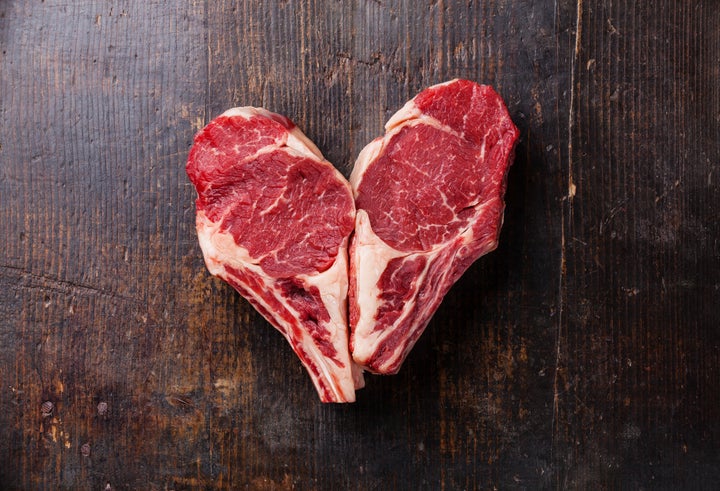
Arguably, no food has caused as big of a stir for as long of a time in both medical and culinary circles as red meat.
Although most studies indicate that curbing consumption of red meat is beneficial to health, the Annals of Internal Medicine published some controversial guidelines about the topic back in October 2019, arguing that meat-eaters are almost incapable of dietary change and should therefore be allowed to continue eating medically unadvised amounts of the protein.
Still, the World Health Organization has classified processed meat as a carcinogen and red meat as a probable one. Studies of all sorts have pointed to the major medical drawbacks associated with Americans’ propensity to overeat red meat.
So, a question still reigns: How much red meat is too much red meat?
What qualifies as red meat?
We should first try to define what the term actually means. According to Stephen Kopecky, a cardiologist at the Mayo Clinic, there are three categories to take into account.
Aside from beef that comes from cows, red meat includes lamb, veal, venison and goat. Pork (“the other white meat”) is often considered red meat nutritionally, but white meat in recipes.
One category includes ground meat, usually made by grinding a whole piece of steak with a lot of fat and turning it into, perhaps, a hamburger. Interestingly, that’s some of the most misleadingly marketed food out there.
“If you go to a store and buy a ground hamburger, they will very proudly advertise it as 90% lean,” Kopecky said. “But what that really means is 10% fat. For instance, whole milk is 3% fat and we consider that a lot, but when they say 90% lean in reference to a hamburger, we think of it as the good stuff.”
Kopecky advises staying away from this sort of meat, or at least trying to minimize consumption.
“It's advised to limit red meat consumption to 3 ounces a day, for a total of 21 ounces per week.”
The next category is one that Kopocky believes most negatively impacts our health: processed meat. “In general, processed meats ― especially the things we eat from convenience stores ― are not good for us because of the salt and chemicals they contain,” he said.
The final category is an entire piece of meat in its most elemental and natural form. Think of a piece of steak, perhaps. “It’s not adulterated, it’s not cooked or processed,” Kopocky said. If you’re going to indulge in red meat, Kopecky suggests this version.
What makes red meat so bad for us?
Overall, compounds found in red meat cause inflammation and irritation to our body tissue. “It’s a minor irritation, but it adds up over the years and it leads to different kinds of damages,” Kopecky explained. This, in turn, causes a slew of medical issues. “Damage of the lining of the arteries leads to atherosclerosis, heart attacks and strokes,” he said. “Damage to the way proteins are being laid down in the brain causes Alzheimer’s, and the damage to DNA leads to mutations that cause cancer.”
Cassidy Gundersen, a health coach and nutritionist, pointed out that “it’s not just one factor in meat that creates the problem of heart disease.” Eating red meat daily, she said, triples your risk of creating trimethylamine N-oxide, an organic compound associated with a heightened risk of heart disease. The protein content of meat, she added, “is an issue because we can’t assimilate it the way we assimilate plant proteins.”
Jennifer Haythe, an associate professor of medicine at the Center for Advanced Cardiac Care at Columbia University Irving Medical Center and a critical care cardiologist at Columbia University Center, also is certain about the problems involved in eating too much red meat.
“Studies have repeatedly demonstrated that high intake of red meat or processed meats is linked to an increased risk of heart disease, cancer and diabetes,” Haythe said. “Conversely, people who have a lower intake of red and processed meats have fewer health risks.”
Another dangerous aspect of consuming red meat involves its fat content, which, according to Gundersen, clogs the arteries and might lead to atherosclerosis and a slew of other diseases.
How much red meat is healthy to eat?
Well, it depends on the type of red meat. According to Kopecky, all processed meat and the majority of ground meat should be avoided.
Haythe suggests chicken, turkey and fish instead of red meat.
As for “whole” red meat, Kopecky advises eating no more than 3 ounces a day, or less than 21 ounces a week.

“A patient will tell me that they have meat only twice or three times a week ― they’ll have a steak, for example,” Kopecky said. “But what size is that steak? Usually 18 ounces. That’s basically what you’re allotted to have all week.”
That advice is in alignment with guidance from the World Cancer Research Fund, which advises limiting the intake of red meat to three portions a week, for a total of about 12 to 18 ounces of cooked weight.
“If you go to a steakhouse with your spouse for your anniversary and order a steak and they bring over a 3-ounce one, you’ll ask for the manager,” Kopecky explained. “We’re not used to that. When we eat a serving of red meat, it is usually 8, 10, 12 ounces ― and that’s a little too much.”
Many carnivores argue that, historically, humans have consumed red meat as a basis of their diet. “Yes, we, as a species, have been eating red meat for millions of years,” Kopecky said. But there’s a catch: “We didn’t have refrigerators and freezers and couldn’t go out and kill a deer for breakfast, so we ate meat in small amounts, intermittently and alongside loads of vegetables, legumes, fruits, grains and plants. Our genome was based on eating meat, but not a whole lot of it. In more recent years, it has been more of a celebratory indulgence.”
Gundersen thinks we should cut out red meat, and meat in general, entirely. “According to the Physicians Committee for Responsible Medicine, we really don’t need any meat in our diet,” she said. “We’re better served by switching to plant-based sources of protein that are going to be more effective, especially for preventing heart disease.” For people worried about heart disease and may be predisposed to it, she advises them to “drop all meat altogether.”
Are there any positives to eating red meat?
Depends on who you ask. Gundersen is adamant that red meat has no health benefits. “There’s nothing exclusive found in red meat that you can’t find elsewhere,” she said. “There’s no reason for people to be eating it, it is best to just forego it altogether.”
Kopecky said red meat can be a good source of protein ― when eaten moderately (remember, 3 ounces a day!).
“But, really, the highest source of protein per calorie is a fungus,” Kopecky explained. “They’ve got a lot of protein and are low on calories. So when people say that they’ve got to eat meat or they won’t have enough protein, I say ... have you ever seen an elephant? An elephant is a vegetarian and it has a ton of muscle!”
Haythe mentioned important nutrients present in red meat, including protein, iron and zinc. “However, there are other more healthy foods that provide” the same nutrients, she said, like spinach, turkey, chicken, legumes, quinoa, fish and broccoli.
Haythe urged those who indulge in red meat to pay attention to cooking methods. “Healthy ways to prepare red meat include grilling, roasting, baking, broiling and press cooking,” she said. “Avoid sauces, marinades, butter and deep-frying. Use olive oil and simple spices instead of sauces and creams heavy in sugar, sodium and fat.”
Should men and women follow the same guidelines?
Yes. Overall, experts agree that the recommended intake of red meat per week is the same across genders. Still, various studies show men are twice as likely as women to suffer from heart attacks, even when accounting for traditional risk factors like diabetes, high cholesterol and blood pressure and body mass.
That may be because men tend to eat more meat than the average woman. “Because their meat consumption is higher, they will have more instances of heart disease,” Gundersen said.

Kopecky suggested that risk multiplication may account for gender imbalances. “If you smoke and eat red meat, it’s worse for you than just eating red meat,” he said. “And men tend to have a little more risk factors.”
Are there ways to offset the negative effects of red meat consumption?
“There’s no supplement you can take that will counter the effects of the food,” Kopecky said. “But studies have actually shown that if you take your cholesterol-lowering drug but don’t eat healthy, the effects of the drugs are attenuated and almost negated. The drug does lower your cholesterol, but it doesn’t lower the risk of a heart attack or a stroke as much as it would if you didn’t eat red meat.”
Gundersen mentioned other ways of potentially reducing the risk of heart disease, including exercising and not smoking. “If you’re having a lot of red meat, frequently exercising and not smoking, then your risk of heart disease overall is reduced,” she said. “But there isn’t necessarily anything you can do to offset the effects of eating red meat.”
What are some good ways to eat less red meat?
The experts mentioned lentils, beans and vegetables as good alternatives. “If you compare one cup of cooked lentils to 3 ounces of ground beef, you’ll notice nearly identical calories and protein content, but the lentils have almost no saturated fat, no cholesterol, tons of fiber and folate, iron and vitamin C,” Gundersen said.
Kopecky suggested making meat the side dish. “The majority of your plate shouldn’t be the red meat to the point that you’re looking for some space to put the vegetables on the side,” he said. “Do it the other way around: Put stuff you really like and is healthy on your plate ― like Brussels sprouts or broccoli ― and then add a little meat to complete the meal.”
Moderation ― of a type that grants you about 21 ounces of red meat per week ― is clearly the key to a healthy lifestyle.